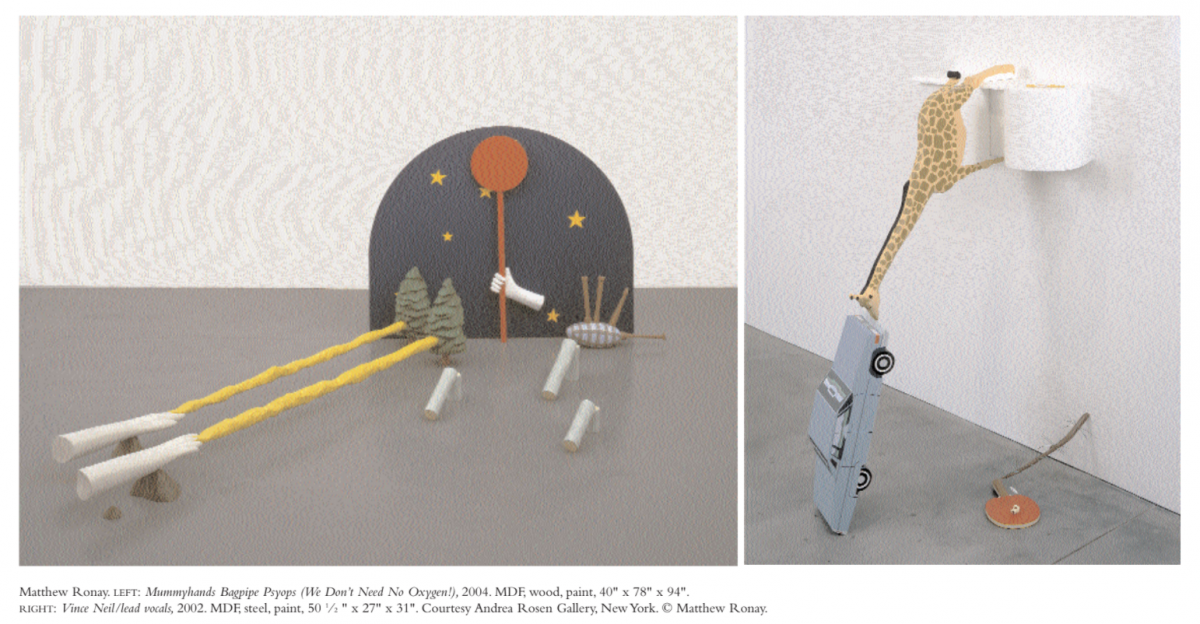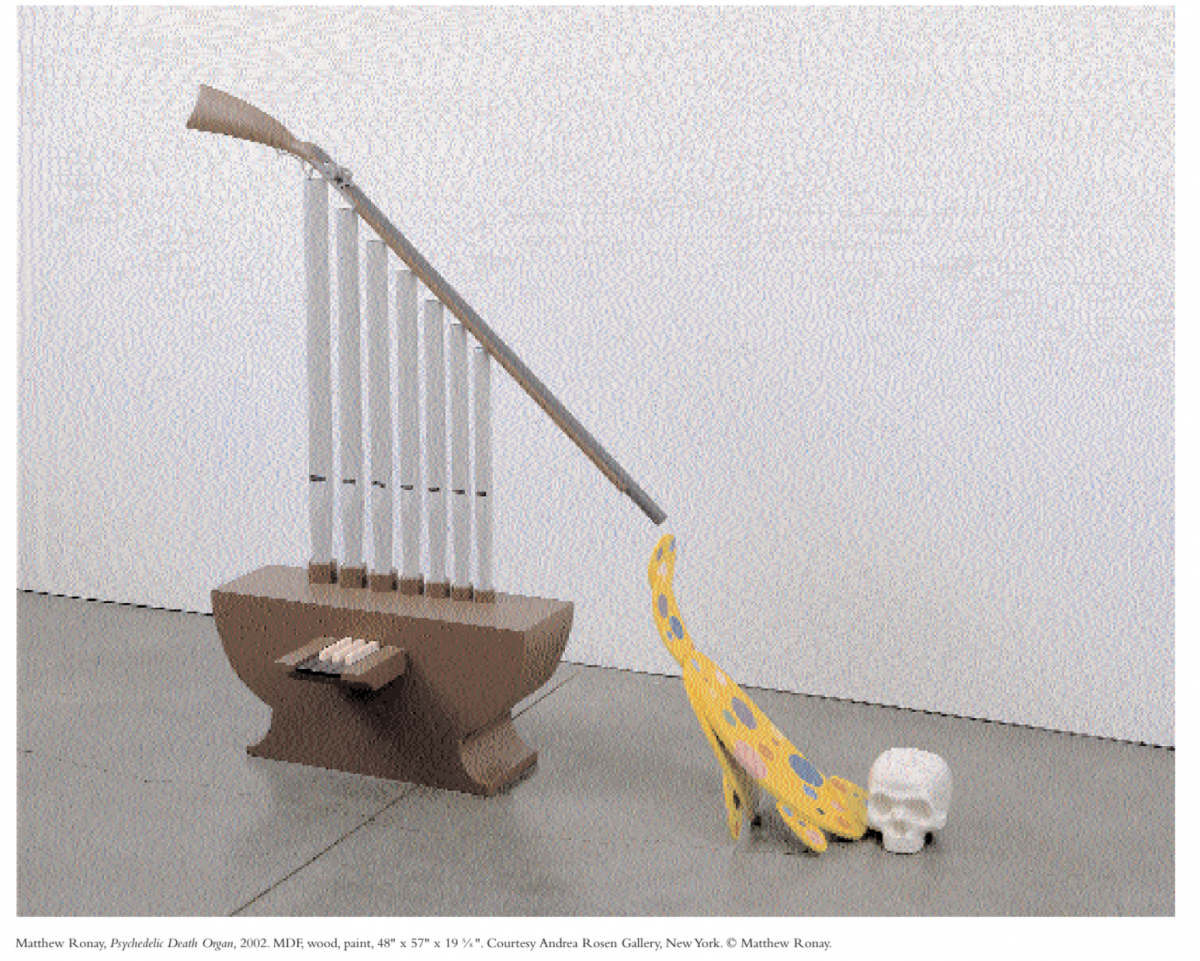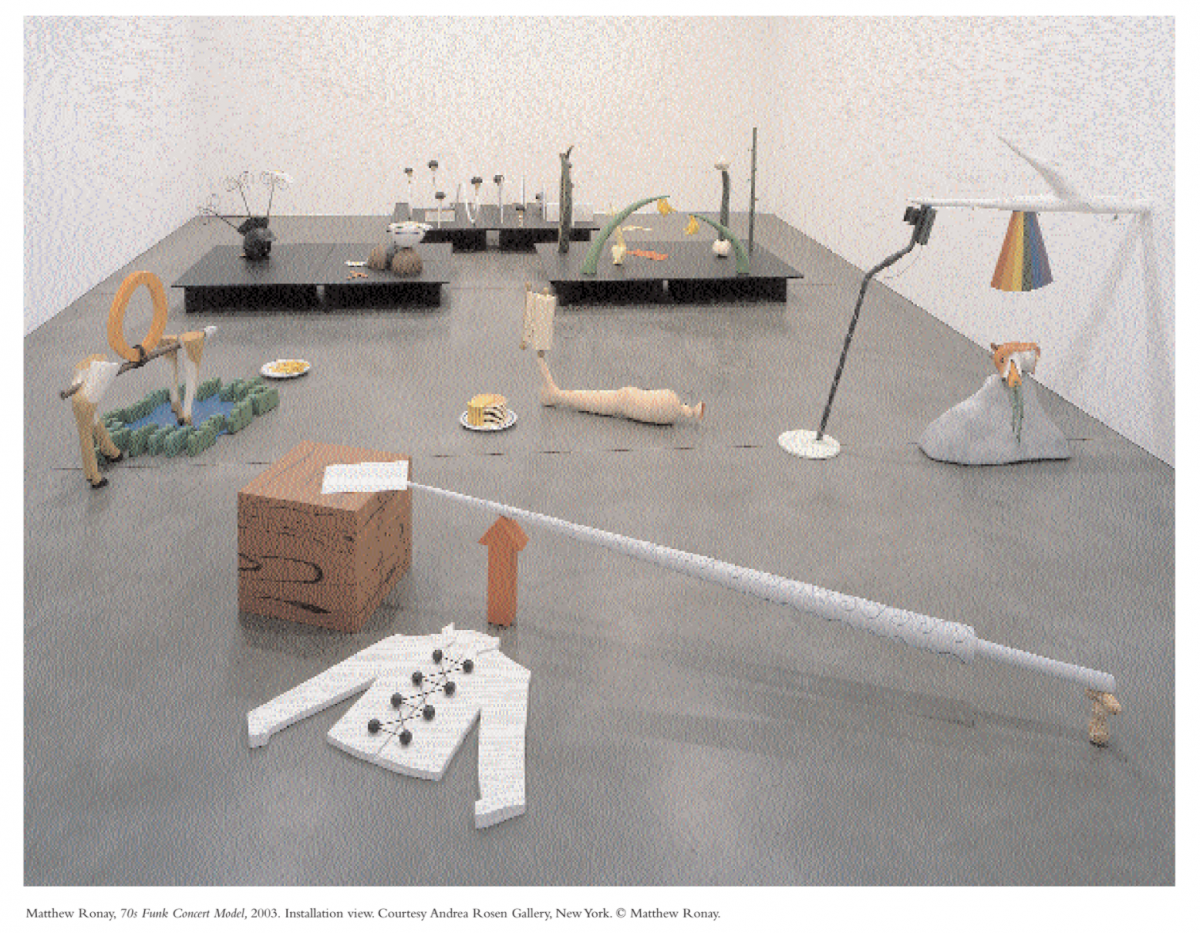With paint, glue, a band saw, and a high-powered sander, Matthew Ronay transforms medium density fiberboard (MDF) into colorful sculptural tableau. (MDF is an engineered wood product made by compressing recovered and recycled wood fiber, and because it has no surface grain, it can be painted to a smooth high-gloss finish.)
A master of elliptical, tumbling visual structures, the twenty-nine-year-old Kentuckian received his M.F.A. from Yale, resides in Brooklyn, and works in Long Island City. Increasingly, Ronay’s Tinker Toys brim with blood, guts, and bodily fluids. For instance, earlier installations that included buttered pancakes and a detached leg with sheet music spinning from its toe (70’s Funk Concert Model), argyle socks caught between a hot dog and a gasoline can (Five-Headed Cock In Drag), and a minimalist retelling of the tale of the fox and the grapes (Fable on faux art deco diving board) have given way to blunter, more transgressive material, which may also be Ronay’s most successful work to date. The new pop-Sade subject matter’s most noticeable in his October 2005 solo show at Marc Foxx in Los Angeles and in an upcoming one-person, one-piece exhibition at Esther Schipper in Berlin. (He’s represented by Andrea Rosen Gallery, whose stable includes high profile artists such as Rita Ackerman, Andrea Zittel, and Walker Evans, as well as emerging artists like David Altmejd and José Lerma.)
Regardless of what he’s cobbling together, Ronay enjambs seemingly unconnected objects into a complex narrative sprawl. In a self-interview he conducted for Uncertain States of America, a group show at Astrup Fearnley Museum in Oslo, Ronay writes, “The work definitely does not illustrate ideas. At least not explicitly concrete ones. It elicits a response. If someone is lazy they would misunderstand the setup as nonsensical or a non sequitur. Instead, what is offered is a chance to create something revealing out of something that is trying to lose its self-consciousness.”
We talked briefly of logistics the night before he flew to Oslo for Uncertain States of America, and continued our discussion upon his return.
—Brandon Stosuy
I. “AT THE END OF ONE OF THESE
PERIODS, PEOPLE LOOSEN UP THEIR
ETHICS AND MORALS AND START TO
GET REALLY DECORATIVE WITH THE
SEX AND TORTURE.”
THE BELIEVER: How was Oslo?
MATTHEW RONAY: I lost four pounds. I ate moose carpaccio in this crazy old hunting bungalow that belongs to the museum’s owner. It was a farmhouse, I guess, which means I lied on my customs application when I said that I wasn’t on a farm or close to livestock. There were lots of great people there who were fun to meet. Some really know how to talk and be really charismatic. I think it’s hard to sound clever and command attention in a group—I just go Tourette’s. The curators made three speeches before the show opened, which was interesting, as in “different and formal.”
BLVR: Why’d they go that route?
MR: I don’t know. While they read all our names out loud I looked at these blond dreadlocks in front of me, and piercings. There were lots of old people sitting in chairs.
BLVR: What work did you show?
MR: Two pieces from It’s an Uprising!: The one with the people being sucked into the cat’s asshole—it’s the reverse rapture, resort thing—and the one with mummy hands zapping the trees because they are trying to get rid of all of the oxygen.
BLVR: There’s a lot of blood in the Marc Foxx show—blood and different sorts of bodily fluids. There are also these erections, some belonging to victims of autoerotic asphyxiation. But the MDF gives it a cartoonish feel.
MR: For me, the show is about the end of an era, like the end of the Roman era, Caligula stuff. Sometimes at the end of one of these periods, people loosen up their ethics and morals and start to get really decorative with the sex and torture. I feel like maybe we are at the end of this period and that, instead of getting hedonistic, we are going to the opposite extreme in our self-extermination. So it’s this kind of emasculating thing where we men start cumming in the toilet or into condoms, anything to stop producing children. Then we begin to replace our pleasure with death to overcome our fear of vanishing. Like that kind of therapy where they make you sleep with snakes to rid you of your fear of them. So cutting out buttholes gets you off, shitting blood is your lube, getting so fat that you can’t see your cock and rats eat it is your goal—stuff like that. I think that terrorism will accelerate modern primitivism way past fashion. As far as the cartoonish feel, it’s a trap door—some people fall into it.
BLVR: You sent me a photo of you at the Foxx show with a nude woman squatting on one of your sculptures. What’s she doing, exactly?
MR: I had this kind of voodoo/invisible magic ceremony before the opening where this porn woman came and rubbed herself on the sculptures. It was a private thing. I thought it would be nice to kind of infect the sculpture with this energy of replacing your sexuality with something non-living. It’s another level of fetish and emasculation; most people hire porn stars to fuck them, not rub themselves on MDF.
BLVR: How’d you get the woman to do it? She looks familiar…
MR: Her name is Liza Harper. She drives a dark blue Magnum. A friend of my brother helped set it up. His friend films porn, I think. She was very professional. I think it was really easy for her, compared to being on a film set and taking it up the butt. I guess the whole thing seems kind of sleazy, which is fine, but additionally I like to think of it as adding a lock of boar’s hair to a cauldron.
II. “WHO ELSE COOKS POPCORN IN
BLOOD WHILE SMOKING JOINTS
AND PLAYING PING-PONG?”
BLVR: On the most basic material level, how do you construct your sculpture? Like, maybe describe a day at the studio.
MR: I try to get here early, and, depending on how many lines of coke I’ve done and how many women I have splayed, whether I got butt-fucked by a huge black guy at an orgy, I get in, like, by 10:30. I respond to email, talk to people if they’re here (we have a 6,000-square-foot place, four of us, with three rentals). Then I start cutting up MDF and gluing it into stacks that eventually I grind into the final shapes. I do a lot of finishing right now to make everything look nice and smooth and uncraftlike—meaning that if it were a painting you wouldn’t see any brushstrokes. I do this by sanding everything a million times. Then I paint things by stippling them. But you wouldn’t see me painting something and cutting it on the band saw at the same time. All of the work starts from drawings, which I don’t do here. I pretty much just fabricate here and look at celebrity candid photo sites and raymitheminx.com. It’s not too romantic, although it is kind of old-school, like making religious sculptures in the Renaissance.
BLVR: You vacillate between coke-fueled sex with women and an orgy that includes “a huge black guy.” What’s your sexual orientation?
MR: I’m straight. I’m into scat stuff, but who isn’t? I really find gay culture rich. Plus it’s not me, so I don’t know it, and so I can be interested in it and inspired by it, and adore it. I don’t take an authoritative position on it, but I find it to be more open to fantasy and everything else.
BLVR: How do you generally apply gay culture to your work?
MR: I don’t know if it’s an application really, but I think of gay culture as a more evolved sensibility—one that, because of attitudes toward it and shit like AIDS, has become more sensitive to existential issues and fantasy vis-à-vis not having the choice to appear “normal.” So its narratives and its implications are more complex than frat guys and Maxim magazine. I guess if I apply it, I do so recklessly, but I want to do it, and I am not going to wait until I am an expert, because I probably won’t be.
BLVR: And where does narrative in general fit into your practice?
MR: I employ narrative as an invitation to think unchoreographically. I hope that the objects work as a kind of trigger for a chain reaction where you are looking at a conveyor belt of hamburgers interspersed with some cocks that have chunks bitten off of them, and you have to create an association. The question should never be “Will they work together?” or “Why can’t they work with something else?” but “How do I get to that specifically atmospheric place?” Any series of objects deciphers the most serpentine of interests, meaning that within any series of objects there are an unlimited amount of contrived ideas. I think that we are not quite clear of a past moment that asks us to be rigid in our mode of interpretation, a postmodern, male type of moment. A moment that maybe is skeptical of unconsciousness (or at least its validity), but, for me, I am ready for some really unexplainable shit. I think narrative sometimes performs as something familiar to get someone to work at thinking.
BLVR: How important is titling?
MR: I guess it depends on the viewer, but I view it as the sign outside the town. You don’t need a bunch of signs telling you where you are after you’ve already arrived.
BLVR: I see a lot of Paul McCarthy in your sculpture. He’s gotten into doing those gigantic inflatable pieces. Do you ever think about constructing something large-scale?
MR: Of course… An Olympic-size swimming pool filled with fresh cum.
BLVR: Would you allow people to swim in it? Maybe a collector, like that Andrea Fraser piece in which a collector paid to have sex with her…
MR: No. I would project movies on it, skip rocks.
BLVR: What kind of person collects your work?
MR: I’m not really involved with collectors unless they come over for visits. I know that in L.A. a bunch of leather guys came to see the show a lot, but that’s a new thing.
BLVR: Actually, some of your stuff looks like it could really lend itself to mass production. How about a Matthew Ronay saltshaker?
MR: I wouldn’t do a saltshaker. I might do a video game. I’m not saying that I don’t think about business, but a good businessperson probably doesn’t try to sell cut-out buttholes hanging on expensive rods.
BLVR: If you could curate a show, whom would you want to include? No restrictions.
MR: OK, this is like a four-month research question. I’d have Robbe-Grillet write a screenplay, Fellini would direct, Paul Rudolph would do the theater (outside), Gaudí interiors, Schiaparelli would do the costumes, Anouk Aimée would star with Vincent Gallo, Jacques Tati sets. I don’t know…
BLVR: Bands and pop references show up in your work via a sculpture titled after Mötley Crüe vocalist Vince Neil, ’70s Funk Concert Model, and the Psychedelic Death Organ.
MR: I listen to a lot of music while I make drawings. The drawings are the birth of a part of a sculpture, so the music colors the drawings sometimes. For my show at Andrea’s, which was about an uprising of sick people, I listened almost exclusively to Miles from the Bitches Brew period.
BLVR: What’s the story behind Vince Neil/lead vocals?
MR: Well, the Vince Neil piece comes from this body of work I created about outlaw bikers. It was about how outlaw bikers were the true embodiment of anarchy, whereas punks were just advertising. I have this thing about Sherlock Holmes and how he finds all of these clues and the clues require these giant leaps in logic. I started to think that this model, the Sherlock one, was in line with my practice, in that all of the objects were there—that viewers just needed the right set of assumptions to kind of make this paradigm shift to create a meaning. Anyway, the thing is that Mötley Crüe took “bikerness” and used it as a kind of wallpaper for their videos. So the biker gang decided to ransack Vince’s apartment. It turns out that he is an art collector, and they steal this site-specific piece from him by cutting out the mantle that the piece depends upon. Then they install it in their biker pad around Christmas. So if you check out the piece in a Sherlock way, it’s all there. There are saw marks on one side of the mantel, Vince Neil’s ID bracelet—the one he’s wearing from the cover of the first album—is there on the mantle, and then there is this Christmas tree branch with a joint on it instead of an ornament, hanging over a bloody piece of popcorn on top of a ping-pong paddle. Who else cooks popcorn in blood while smoking joints and playing ping-pong? It could be anyone, but I said “bikers.”

III. “IT’S PARTLY ABOUT PARTYING AND PARTLY ABOUT
BEING SOCIALLY AWARE.”
BLVR: You also make music. Can you tell me more about this CD you’re currently putting together?
MR: The band is Ben Brantley (another Louisville guy) and me. It’s tentatively called Last-Nite. We’re remixing it right now. It’s basically an R&B funk band, but through the ears of two kids who grew up in Kentucky listening to punk rock. We’ve been working on it forever. We started it before I did [’70s Funk Concert Model] for the Biennial, about how current pop doesn’t come close to being as inspired and enlightening as ’70s funk. Or maybe it was about how the current attitude’s not fluid enough to find out through music and art what’s going on in the world. This might be because of CNN, the internet, whatever. So we started it out of the necessity to make music like that—it’s partly about partying and partly about being socially aware. Ben and I have been playing together for over ten years doing all sorts of different projects. This is just the newest. Each of us plays a million things on each track, so it would almost be impossible for us to play live unless we hired a band or something.
BLVR: Do you plan to overlap Last-Nite with your art?
MR: I don’t think I want it to be an art band, so no. I have been playing music as long as I have been making art. I think that the two are linked loosely by content. Maybe just in the desire to put forth a social proposition.
BLVR: What do you play?
MR: Ben writes most of the music and plays bass, guitar, and keys. I do most of the singing, drumming, horn arrangements.
BLVR: Whom do you consider a part of your artistic peer group?
MR: If “peer group” means “other people my age whose sensibilities are interesting to me,” then: Nathan Carter, Trisha Donnelly, Adam Putnam, Jason Dodge.
BLVR: Trisha went to Yale, too, right? Did you know her there?
MR: Of course—Trisha gave me a copy of Play It As It Lays for my birthday at Yale. Adam and Nathan were there, and Jason too, but not as a student.
BLVR: Whether they’re for or against them, people are obsessed with the intersection of the art market and M.F.A. programs. Do you think you could’ve established your practice without the degree?
MR: I would hope that I could have, but I doubt it. If I look back, there were people that I met who helped get things rolling, and I guess if I hadn’t met them it might not have happened, but I don’t know. Youth has always been a talent, though, so I don’t think that M.F.A. art market analysis is a new quandary. Maybe the real thing is the art world’s transformation into an industry—maybe people should be looking at that.
BLVR: I noticed everyone mentions Calvino as well as nouveau roman authors in relation to your work. What other authors are there that folks are missing?
MR: Yes, it’s true. It was in the Biennial catalog. I don’t really think that Calvino is nouveau roman—is he? I think of him as more Oulipo, like Georges Perec, Harry Mathews, Raymond Queneau—I love those guys. Then pre-nouveau roman: Raymond Roussel. There are a lot of nouveau roman authors, though, and I like most of them. Other authors: Orhan Pamuk, Michael Herr, J. G. Ballard, and Dennis Cooper. Noir stuff. Carver. Southern stuff. Faulkner. Then something like Nabokov’s Pale Fire.

BLVR: Dennis Cooper mentions you on his blog.
MR: I just read The Sluts and God Jr. last week. I love Dennis. I like to think of the end of an era as something sexually reversed and disturbing. A loosening of morals and ethics is a symptom of the end, but the end is exponential and so exciting.
BLVR: Your consideration of doing a video game reminds me of God Jr. I could imagine you doing a large sculpture like one the father constructs from his son’s stoned video-game sketches. Am I off?
MR: That book is fucking amazing. That monument reminds me of the Watts Towers in L.A. somehow. I don’t think you’re off, but the monument that Dennis creates in the book is amazing because it’s writing, and things in writing can be perfect and so ambiguous. He keeps us from being able to completely visualize it. I guess you can do that with sculpture, and it’s called “abstraction” or “dimming the lights,” but it would be great if you could visually complete something in someone’s mind like it can be completed in writing.
IV. CUPCAKE ANAL BEADS ARE FREEDOM.
BLVR: Can you tell me about the new work you’re doing for the Project Room in Esther Schipper?
MR: It’s a patent leather black dildo rubbing against a half-dog (that’s half-little-girl) and a twenty-foot-long set of anal beads made of cupcakes, with a finish line. The anal beads hang from the ceiling and intersect the floor right next to the half-dog-thingy. The dog is cut in half but it’s not bleeding. The dildo is rubbing on the cut side of the dog, almost going in this hole that is probably a windpipe. All of that is just about to cross a finish line, which is about ten inches off the ground. The title of the piece is Love will find a way. It’s possibly about a way to get off that is outside of the standard. Like shitting behind the stairs. It’s a fetish, like fucking someone’s guts, literally. But it’s also about tenderness, because it has to be.
BLVR: What are the cupcake anal beads all about?
MR: It just feels right, like a very complex desire to push food into your ass and try to pull it out on a string. It’s really backwards, but who would want to deny someone the pleasure? Cupcake anal beads are freedom.
BLVR: What would you imagine as a soundtrack for the piece?
MR: “For Doz That Slept” by Black Sheep, from A Wolf in Sheep’s Clothing, or “If You Had Lips” by the Jesus Lizard from Head/Pure—“Ancient man—he needed / Ancient man—he had it.” It’s funny that you ask because the title comes from this Sam Cooke song, “If love wants to travel to your heart, love will find a way.” I’d go with that… You can’t beat that. And I’m not into irony. Even With “For Doz That Slept.” The song just says fuck you over and over again in different melodies. It’s a dis for those who think they are boring or stupid. But I was thinking that it’s also a come-on. Like: “If you think I am boring and fall asleep, I’ll fuck you into waking up.” Does that make sense?
BLVR: It does, yeah. Have you ever seen Jesus Lizard live? At a CBGB’s show once, David Yow bent over and opened his asshole very wide. Very Pink Flamingos.
MR: When you first said “pink flamingos,” I thought that his asshole had lips, like a pussy that looked like wings, with two long lobelike hemorrhoid things. I did see them in Cincinnati at this place that was half Laundromat, half club/bar. I think it was called Sudsy’s or something. He did get naked and spit and try to touch people, but I was looking at the drummer the whole time.
BLVR: Do you have plans yet for the shows in Madrid or at Parasol Unit in London?
MR: I do, but they change all the time. I know for sure that there are two guys behind the bushes for my show in Madrid, and a black guy in a red banana hammock, but those are just two parts.
BLVR: You mention black men a lot. Are you the new Mapplethorpe?
MR: That’s sweet of you, but I don’t think so. The reason I mentioned being fucked by a big black guy earlier was because I believed it would paint a more hedonistic picture of an orgy. Plus, I have to admit—my description is similar to the description Fellini gives Terrence Stamp when Stamp asks him how to play Toby Dammit. Toby Dammit is supposed to be giving a speech for receiving the Golden Wolf (the Italian Oscar), so Fellini says, “You’ve just been doing coke and LSD for two weeks straight and you were at an orgy being fucked by a black guy in the ass… action!” When faced with the description of my banal studio routine I embellished—and now look at the consequences. But really, people are amazing, and I want to get into them. There is only so much of your own kind that you can get into.






